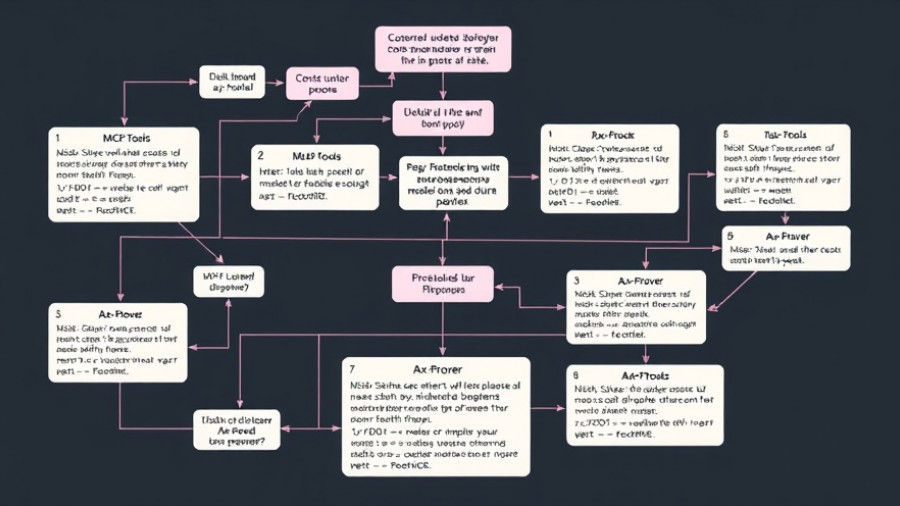
Understanding Ax-Prover: An AI Leap Forward in Theorem Proving
The emergence of deep reasoning AI with frameworks like Ax-Prover marks an exciting development in both artificial intelligence and formal logic. Designed by a collaboration of researchers from Axiomatic AI and leading experts in science, Ax-Prover represents a multi-agent system that skillfully navigates complex problems in mathematics and quantum physics. By harmonizing the reasoning capabilities of large language models with the rigorous formal tools found in Lean—a well-regarded theorem proving environment—Ax-Prover has begun to pave new pathways in automated theorem proving.
Bridging Collaboration Between AI and Humans
Traditional approaches to theorem proving have often mandated highly specialized systems, limiting flexibility and application scope. However, Ax-Prover's innovative framework allows for both autonomous functioning and collaborative interactions with human experts. This dual capability is a significant step forward, as it enables mathematicians and physicists to leverage AI while maintaining rigorous formal proof standards.
The Role of Large Language Models in Theorem Proving
Large language models (LLMs), such as GPT-4 and its contemporaries, form a core part of the Ax-Prover's architecture. These models recognize patterns and natural language elements to facilitate theorem proving processes. Ax-Prover extends this capability by employing LLMs not just as passive tools but as active agents in scientific reasoning. The integration with the Lean environment through the Model Context Protocol allows for fluid transitions between creative problem-solving and strict syntactic rigor, marking a significant advance in the potential for AI applications in STEM fields.
Assessing Performance: A New Standard
To evaluate Ax-Prover's capabilities, the research team benchmarked the system against best-in-field theorem provers and large language models across established datasets like NuminaMath-LEAN and PutnamBench. Introduced datasets, AbstractAlgebra and QuantumTheorems, helped to assess the framework on less explored but crucial areas in abstract algebra and quantum theory. Remarkably, Ax-Prover has demonstrated not only competitive performance but also superior outcomes when tackling these new benchmarks, suggesting that it is not constrained by traditional limitations of specialised systems.
The Future of Automated Theorem Proving
The revelations stemming from Ax-Prover prompt a reflection on the future capabilities of AI deep reasoning systems. As these models continue to evolve, the potential for greater integration in professional scientific domains appears promising. With applications now spanning mathematics, physics, and potentially even beyond into other scientific territories, Ax-Prover sets the stage for a new era of automated reasoning.
Empowering Scientific Inquiry Through Theorems
Imagine a world where mathematicians unchain their creativity, using AI to tackle theorem proving as easily as composing a new idea. Ax-Prover allows for such intellectual freedoms, ultimately empowering humans to focus on creative synthesis rather than rote verification. The collaborative efforts between Ax-Prover and expert mathematicians showcase its assistant capabilities, one example being its aid in formalizing a complex cryptography theorem.
Laying the Groundwork for Broader Applications
The design philosophy behind Ax-Prover speaks volumes about the future of AI technologies in the natural sciences. By providing tools that not only autonomously prove theorems but also enrich collaborative discussions, researchers harness their creative intellect alongside a powerful reasoning framework. Such amalgamation fuels further exploration and inquiry, propelling both mathematics and quantum physics into exciting new territories.
Concluding Thoughts on Deep Reasoning AI
As AI continues to deepen its integration into scientific research, frameworks like Ax-Prover are crucial in simplifying complex processes while promoting collaboration. To those fascinated by these advances, it's vital to monitor developments and consider how such technologies can facilitate personal insights and wider societal implications.
Stay informed about advancements in deep reasoning AI and explore how these technologies can reshape your understanding of mathematics and science! Sign up for updates on the latest in AI and theorem proving.
 Add Row
Add Row  Add
Add 




Write A Comment